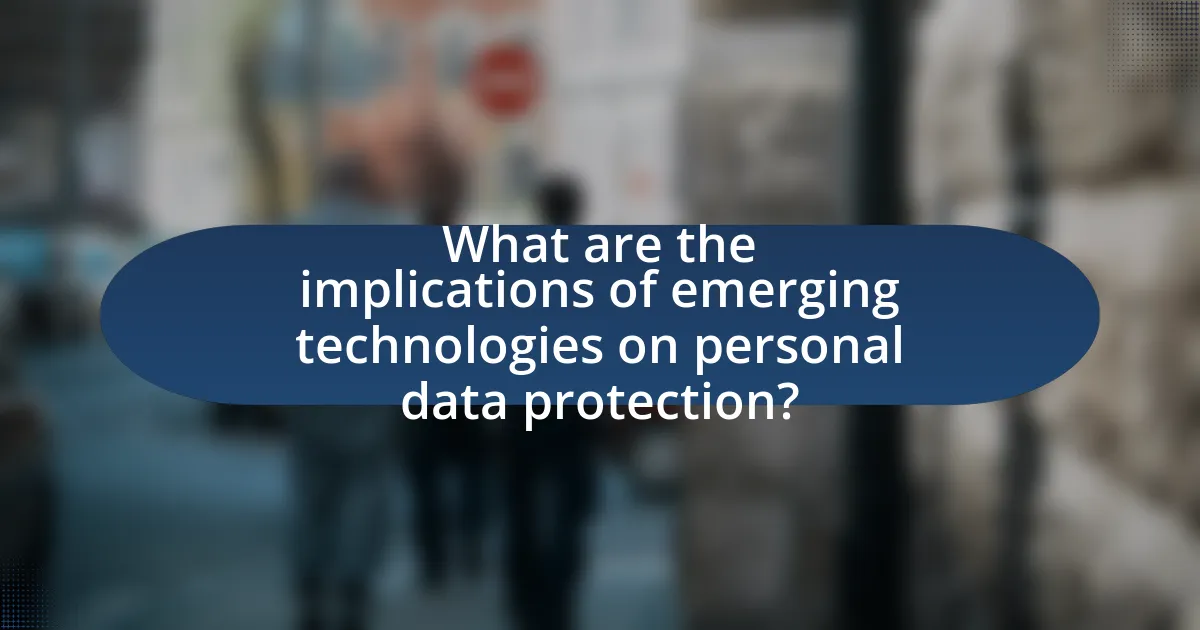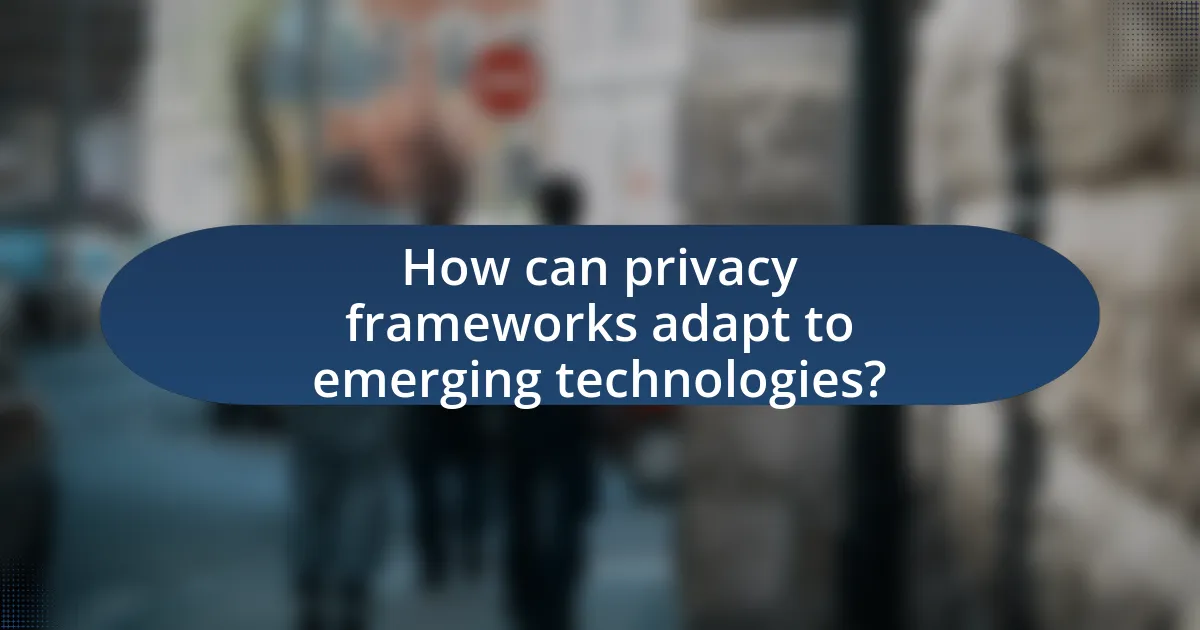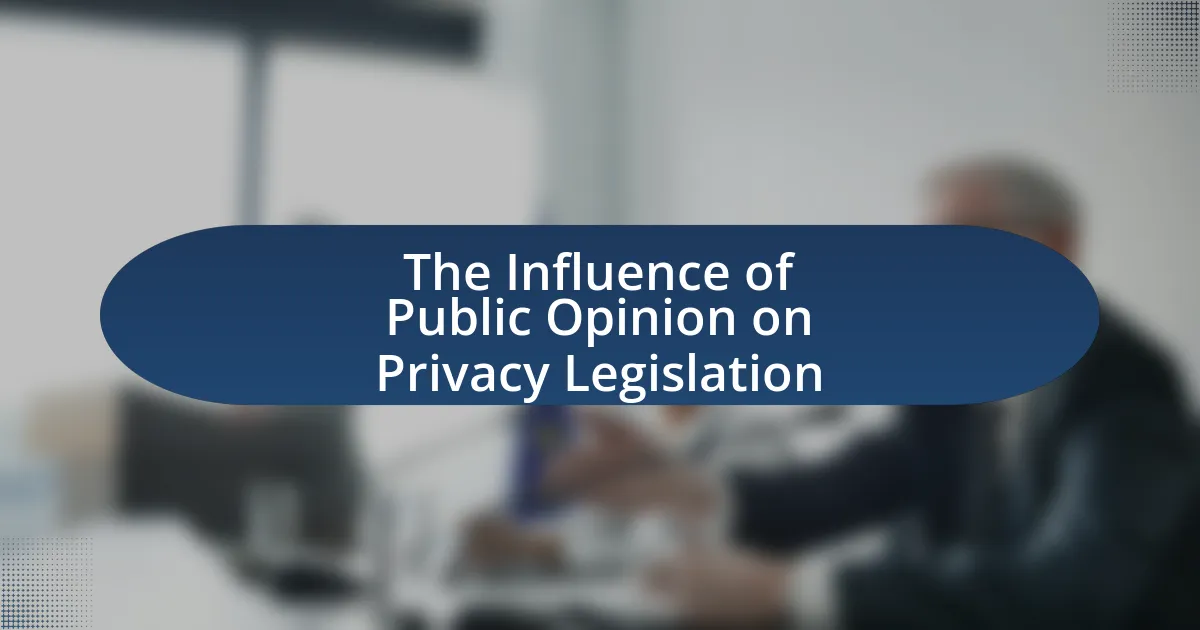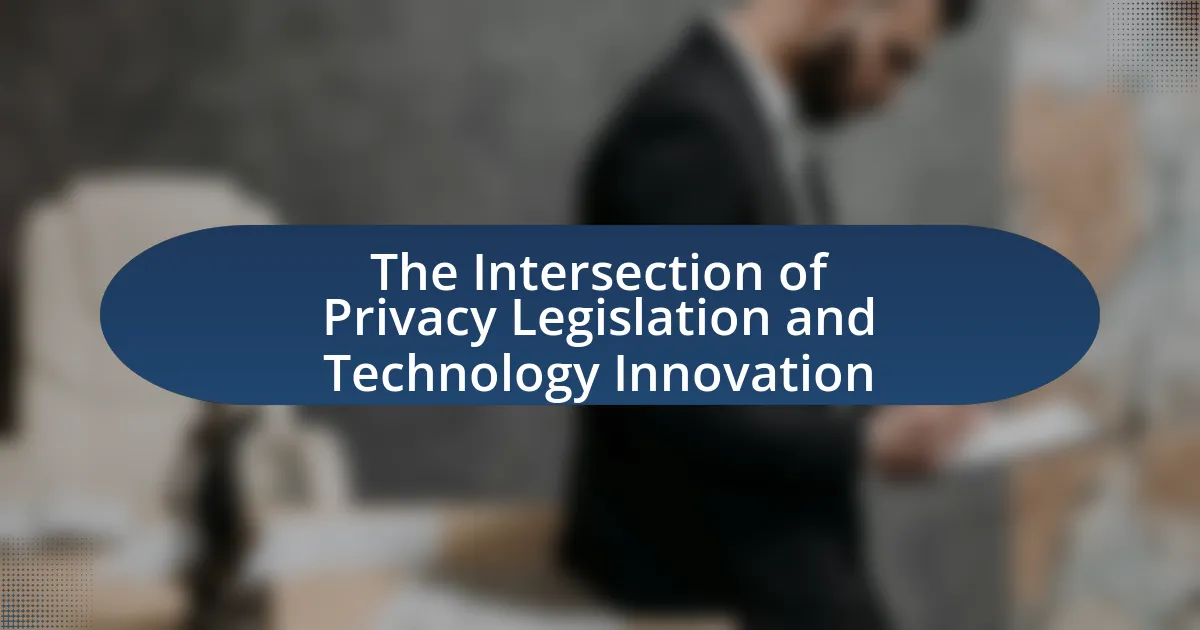Emerging technologies, including artificial intelligence, blockchain, the Internet of Things (IoT), and 5G networks, are significantly disrupting existing privacy frameworks by introducing new data collection methods and altering user consent dynamics. These advancements challenge traditional notions of privacy, as they enable extensive data analysis often without explicit user consent, leading to increased surveillance and potential misuse of personal information. Current regulations, such as the General Data Protection Regulation (GDPR), struggle to keep pace with these rapid technological changes, resulting in gaps that necessitate updated privacy frameworks. The article explores the implications of these technologies on personal data protection, the limitations of existing privacy laws, and strategies for enhancing privacy protections in a digital landscape increasingly defined by technological innovation.

How do emerging technologies impact existing privacy frameworks?
Emerging technologies significantly disrupt existing privacy frameworks by introducing new data collection methods and altering user consent dynamics. For instance, advancements in artificial intelligence and big data analytics enable organizations to gather and analyze vast amounts of personal information, often without explicit user consent. A study by the Electronic Frontier Foundation highlights that technologies like facial recognition and Internet of Things devices can lead to pervasive surveillance, challenging traditional notions of privacy. Furthermore, existing regulations, such as the General Data Protection Regulation (GDPR), struggle to keep pace with rapid technological advancements, resulting in gaps that can be exploited. This mismatch between technology and regulation underscores the urgent need for updated privacy frameworks that address the complexities introduced by these innovations.
What are the key emerging technologies affecting privacy?
Key emerging technologies affecting privacy include artificial intelligence, blockchain, the Internet of Things (IoT), and 5G networks. Artificial intelligence, particularly through machine learning algorithms, enables extensive data analysis and profiling, often without user consent, raising significant privacy concerns. Blockchain technology, while offering enhanced security and transparency, can also lead to permanent data storage that complicates the right to be forgotten. The Internet of Things connects numerous devices that collect and transmit personal data, increasing the risk of unauthorized access and surveillance. Lastly, 5G networks facilitate faster data transmission, which can enhance data collection capabilities but also amplify privacy risks due to the sheer volume of data generated. These technologies collectively challenge existing privacy frameworks by complicating consent, data ownership, and the management of personal information.
How does artificial intelligence challenge privacy norms?
Artificial intelligence challenges privacy norms by enabling extensive data collection and analysis, often without explicit consent from individuals. AI systems can process vast amounts of personal information, including behavioral patterns and preferences, which can lead to intrusive surveillance and profiling. For instance, a study by the Electronic Frontier Foundation highlights that AI technologies, such as facial recognition, can track individuals in public spaces, undermining the expectation of privacy. Additionally, the Cambridge Analytica scandal demonstrated how AI-driven data mining can exploit personal data from social media platforms, raising significant ethical concerns regarding user consent and data ownership. These examples illustrate how AI not only complicates existing privacy frameworks but also necessitates a reevaluation of legal standards to protect individual privacy rights.
What role does blockchain play in privacy protection?
Blockchain enhances privacy protection by enabling decentralized data storage and cryptographic security measures. This technology allows individuals to control their personal information without relying on centralized entities, reducing the risk of data breaches. For instance, blockchain’s immutable ledger ensures that once data is recorded, it cannot be altered or deleted, providing a transparent and secure method for managing sensitive information. Additionally, the use of public and private keys in blockchain transactions allows users to share information selectively, further safeguarding their privacy. Studies have shown that blockchain can significantly mitigate risks associated with data privacy, as evidenced by its implementation in sectors like finance and healthcare, where data integrity and confidentiality are paramount.
Why are existing privacy frameworks becoming outdated?
Existing privacy frameworks are becoming outdated due to rapid advancements in technology that outpace regulatory measures. Technologies such as artificial intelligence, big data analytics, and the Internet of Things generate vast amounts of personal data, often in ways that existing frameworks do not adequately address. For instance, the General Data Protection Regulation (GDPR), implemented in 2018, struggles to keep up with the complexities of data processing and sharing in real-time environments. Additionally, the rise of cross-border data flows complicates compliance, as different jurisdictions have varying privacy laws, leading to inconsistencies and gaps in protection. These factors collectively highlight the inadequacy of current privacy frameworks in addressing the evolving landscape of data privacy challenges.
What limitations do current privacy laws have in addressing new technologies?
Current privacy laws often fail to adequately address new technologies due to their reactive nature and lack of specificity. Many existing regulations, such as the General Data Protection Regulation (GDPR), were designed before the advent of advanced technologies like artificial intelligence and blockchain, leading to gaps in coverage. For instance, GDPR does not explicitly account for the complexities of data processing in machine learning, where data can be anonymized and yet still pose privacy risks. Additionally, the rapid pace of technological innovation outstrips the legislative process, resulting in outdated frameworks that cannot effectively regulate emerging practices such as biometric data collection or the Internet of Things (IoT). This misalignment creates challenges in enforcing privacy rights and protecting individuals’ data in a digital landscape that evolves continuously.
How do societal expectations of privacy evolve with technology?
Societal expectations of privacy evolve with technology as advancements create new contexts for data collection and sharing, leading to shifting norms regarding what is considered acceptable. For instance, the rise of social media platforms has transformed privacy expectations, with users often sharing personal information publicly, which contrasts with previous norms of discretion. Research indicates that as technology becomes more integrated into daily life, such as through smartphones and smart devices, individuals increasingly accept surveillance and data collection in exchange for convenience and personalized services. A study by the Pew Research Center found that 79% of Americans are concerned about how companies use their data, yet many continue to use services that require data sharing, illustrating a complex relationship between technological convenience and privacy expectations.

What are the implications of emerging technologies on personal data protection?
Emerging technologies significantly impact personal data protection by introducing new vulnerabilities and challenges to existing privacy frameworks. For instance, advancements in artificial intelligence and machine learning enable the collection and analysis of vast amounts of personal data, often without explicit consent, which can lead to unauthorized data usage. A study by the European Union Agency for Cybersecurity highlights that the integration of Internet of Things devices increases the risk of data breaches, as these devices often lack robust security measures. Additionally, blockchain technology, while offering potential for secure data transactions, also raises concerns about the immutability of personal data, complicating the right to erasure under regulations like the General Data Protection Regulation. These implications necessitate a reevaluation of current privacy laws to address the evolving landscape of data protection in the face of rapid technological advancements.
How do emerging technologies facilitate data collection?
Emerging technologies facilitate data collection by enabling real-time data acquisition and analysis through advanced tools such as IoT devices, artificial intelligence, and big data analytics. For instance, IoT devices can continuously gather data from various environments, providing a constant stream of information that can be processed and analyzed for insights. According to a report by McKinsey, the IoT could generate up to $11 trillion in economic value by 2025, largely due to enhanced data collection capabilities. Additionally, artificial intelligence algorithms can analyze vast datasets quickly, identifying patterns and trends that would be impossible for humans to discern manually. This combination of technologies not only increases the volume of data collected but also improves the accuracy and relevance of the insights derived from that data.
What types of data are most vulnerable to exploitation?
Personal data, particularly sensitive information such as social security numbers, financial records, and health information, are the types of data most vulnerable to exploitation. This vulnerability arises from the increasing use of digital platforms and the prevalence of data breaches; for instance, the Identity Theft Resource Center reported over 1,100 data breaches in the U.S. in 2020 alone, exposing millions of personal records. Additionally, data collected through emerging technologies like IoT devices and mobile applications often lack robust security measures, making them prime targets for cybercriminals.
How does the Internet of Things (IoT) affect data privacy?
The Internet of Things (IoT) significantly impacts data privacy by increasing the volume and variety of personal data collected from users. IoT devices, such as smart home appliances and wearable technology, continuously gather sensitive information, which can be vulnerable to unauthorized access and breaches. A report by the Ponemon Institute in 2020 indicated that 63% of organizations experienced a data breach due to insecure IoT devices, highlighting the risks associated with inadequate security measures. Furthermore, the interconnected nature of IoT devices can lead to cascading privacy violations, where a breach in one device compromises the data of others. This evolving landscape challenges existing privacy frameworks, necessitating updated regulations and security protocols to protect user data effectively.
What risks do individuals face with the rise of these technologies?
Individuals face significant risks with the rise of emerging technologies, primarily related to privacy breaches, data misuse, and surveillance. As technologies such as artificial intelligence and the Internet of Things proliferate, personal data becomes increasingly vulnerable to unauthorized access and exploitation. For instance, a report by the Electronic Frontier Foundation highlights that over 80% of Americans are concerned about their personal information being collected without consent. Additionally, the Cambridge Analytica scandal exemplifies how data harvested from social media can be manipulated for political purposes, illustrating the potential for misuse. These risks underscore the urgent need for robust privacy frameworks to protect individuals in a rapidly evolving technological landscape.
How can personal data be misused in the digital age?
Personal data can be misused in the digital age through unauthorized access, data breaches, and exploitation by third parties. Unauthorized access occurs when hackers infiltrate systems to steal sensitive information, as evidenced by the 2020 Twitter breach where attackers accessed private accounts and personal data of high-profile users. Data breaches, such as the 2017 Equifax incident, exposed the personal information of approximately 147 million individuals, leading to identity theft and financial fraud. Additionally, companies may exploit personal data for targeted advertising without user consent, as seen in the Cambridge Analytica scandal, where data from millions of Facebook users was harvested for political advertising. These instances illustrate the significant risks associated with personal data misuse in the digital landscape.
What are the psychological impacts of surveillance technologies?
Surveillance technologies significantly impact psychological well-being by inducing feelings of anxiety, paranoia, and a diminished sense of autonomy. Research indicates that constant monitoring can lead to heightened stress levels, as individuals may feel they are always being watched, which can result in self-censorship and altered behavior. A study published in the journal “Computers in Human Behavior” found that individuals exposed to surveillance reported increased anxiety and discomfort, suggesting that the awareness of being monitored can negatively affect mental health. Furthermore, the perception of surveillance can erode trust in institutions and relationships, leading to social withdrawal and a sense of isolation.

How can privacy frameworks adapt to emerging technologies?
Privacy frameworks can adapt to emerging technologies by incorporating flexible guidelines that address the unique challenges posed by innovations such as artificial intelligence, blockchain, and the Internet of Things. These frameworks must evolve to include principles like data minimization, user consent, and transparency, which are essential in managing the complexities of new data processing methods. For instance, the General Data Protection Regulation (GDPR) has already begun to address these issues by emphasizing the importance of privacy by design and by default, which encourages organizations to integrate privacy considerations into their technological developments from the outset. Additionally, ongoing stakeholder engagement, including input from technology developers, legal experts, and civil society, is crucial for ensuring that privacy frameworks remain relevant and effective in the face of rapid technological advancements.
What strategies can be implemented to enhance privacy protections?
Implementing data minimization strategies enhances privacy protections by limiting the collection and retention of personal information. Organizations can adopt practices such as anonymization and pseudonymization to reduce the risk of identifying individuals from data sets. For instance, the General Data Protection Regulation (GDPR) emphasizes data minimization as a core principle, requiring entities to collect only the data necessary for their specific purposes. Additionally, employing strong encryption methods for data at rest and in transit further safeguards personal information from unauthorized access. Research by the Electronic Frontier Foundation highlights that encryption significantly reduces the likelihood of data breaches, thereby reinforcing privacy protections.
How can policymakers create flexible regulations for new technologies?
Policymakers can create flexible regulations for new technologies by adopting a principles-based approach that emphasizes adaptability and stakeholder engagement. This approach allows regulations to evolve alongside technological advancements, ensuring they remain relevant and effective. For instance, the European Union’s General Data Protection Regulation (GDPR) incorporates flexibility through its risk-based framework, enabling organizations to tailor compliance measures based on the specific risks associated with their technologies. Additionally, continuous dialogue with industry experts and the public can inform policymakers about emerging trends and challenges, facilitating timely updates to regulations. This method not only addresses the dynamic nature of technology but also fosters innovation while protecting privacy rights.
What role do organizations play in safeguarding user privacy?
Organizations play a critical role in safeguarding user privacy by implementing data protection policies and practices that comply with legal standards. These organizations are responsible for ensuring that user data is collected, stored, and processed securely, minimizing the risk of unauthorized access or breaches. For instance, the General Data Protection Regulation (GDPR) mandates that organizations must obtain explicit consent from users before processing their personal data, thereby reinforcing user control over their information. Additionally, organizations often invest in technologies such as encryption and anonymization to protect sensitive data, which further enhances user privacy.
What best practices should individuals follow to protect their privacy?
Individuals should follow several best practices to protect their privacy, including using strong, unique passwords for different accounts, enabling two-factor authentication, and being cautious about sharing personal information online. Strong passwords reduce the risk of unauthorized access, as studies show that 81% of data breaches are linked to weak passwords. Two-factor authentication adds an additional layer of security, making it harder for attackers to gain access even if they have the password. Furthermore, individuals should regularly review privacy settings on social media and other online platforms to control who can see their information. Being mindful of the information shared, especially on public forums, is crucial, as 70% of people have experienced some form of online privacy violation. By implementing these practices, individuals can significantly enhance their privacy protection in an increasingly digital world.
How can users manage their digital footprints effectively?
Users can manage their digital footprints effectively by regularly reviewing and adjusting their privacy settings across online platforms. This includes disabling location tracking, limiting data sharing with third-party applications, and using privacy-focused browsers or search engines. Research indicates that individuals who actively manage their privacy settings can significantly reduce their exposure to data collection, as evidenced by a study from the Pew Research Center, which found that 81% of Americans feel they have little to no control over the data collected about them online. By being proactive in these areas, users can better protect their personal information and maintain their privacy in an increasingly digital world.
What tools are available for enhancing personal privacy online?
Tools available for enhancing personal privacy online include Virtual Private Networks (VPNs), encrypted messaging apps, privacy-focused web browsers, and ad blockers. VPNs, such as NordVPN and ExpressVPN, encrypt internet traffic, masking users’ IP addresses and locations. Encrypted messaging apps like Signal and WhatsApp provide end-to-end encryption, ensuring that only the intended recipients can read messages. Privacy-focused web browsers, such as Brave and Firefox, block trackers and ads, enhancing user anonymity. Ad blockers like uBlock Origin prevent intrusive advertisements and tracking scripts from collecting user data. These tools collectively contribute to a more secure online experience by protecting personal information from unauthorized access and surveillance.
What future trends should we anticipate in privacy frameworks?
Future trends in privacy frameworks will likely include increased regulatory scrutiny, the adoption of privacy by design principles, and the integration of artificial intelligence for compliance monitoring. Regulatory bodies are enhancing their focus on data protection, as seen with the implementation of the General Data Protection Regulation (GDPR) in Europe, which has set a precedent for stricter privacy laws globally. Privacy by design emphasizes embedding privacy measures into the development process of technologies, ensuring that data protection is a foundational aspect rather than an afterthought. Additionally, the use of AI tools for real-time compliance monitoring is emerging, allowing organizations to proactively manage privacy risks and adhere to evolving regulations. These trends reflect a shift towards more robust and proactive privacy management in response to technological advancements.
How might technology continue to reshape privacy expectations?
Technology will continue to reshape privacy expectations by introducing advanced data collection methods and increasing user awareness of data usage. For instance, the rise of artificial intelligence and machine learning enables companies to analyze vast amounts of personal data, leading to more personalized services but also heightened concerns about surveillance and data misuse. According to a 2021 report by the Pew Research Center, 81% of Americans feel that the risks of data collection by companies outweigh the benefits, indicating a shift in public sentiment towards privacy. As technology evolves, regulations like the General Data Protection Regulation (GDPR) in Europe set new standards for data protection, further influencing how individuals perceive their privacy rights.
What innovations could emerge to protect privacy in the future?
Innovations that could emerge to protect privacy in the future include advanced encryption techniques, decentralized identity systems, and privacy-preserving machine learning. Advanced encryption techniques, such as homomorphic encryption, allow data to be processed without being decrypted, ensuring privacy during computation. Decentralized identity systems, leveraging blockchain technology, enable individuals to control their personal information without relying on centralized authorities, reducing the risk of data breaches. Privacy-preserving machine learning methods, like federated learning, allow models to be trained on user data without exposing the data itself, thus maintaining user privacy. These innovations are supported by ongoing research in cryptography and data protection, highlighting their potential effectiveness in safeguarding privacy in an increasingly digital world.





